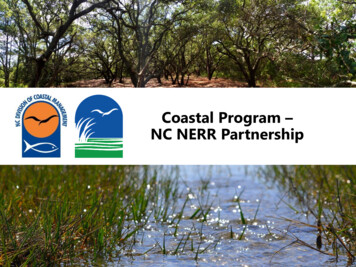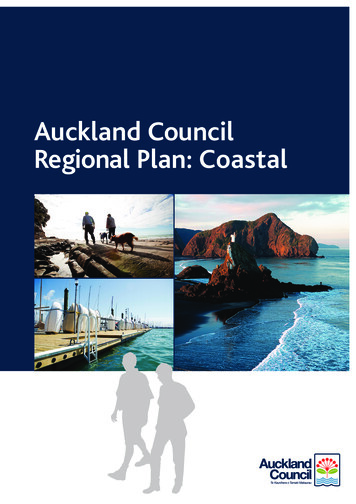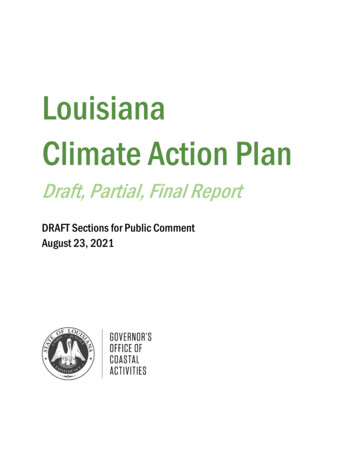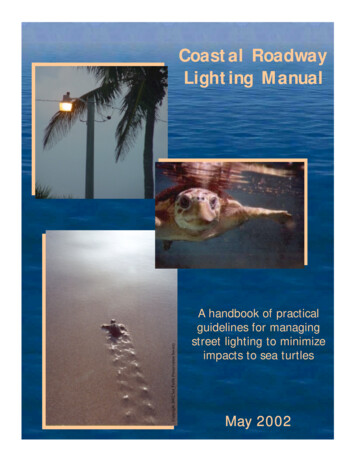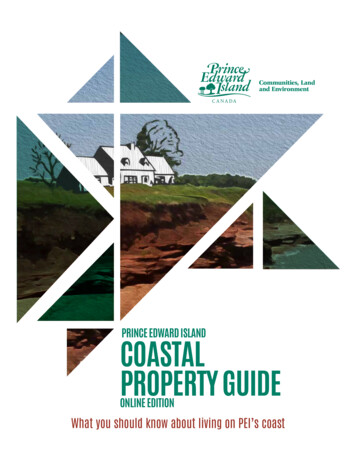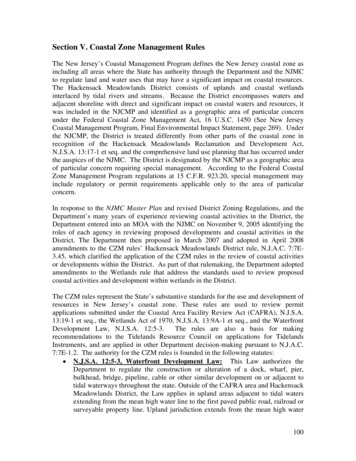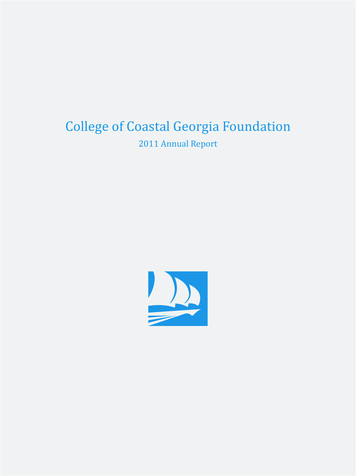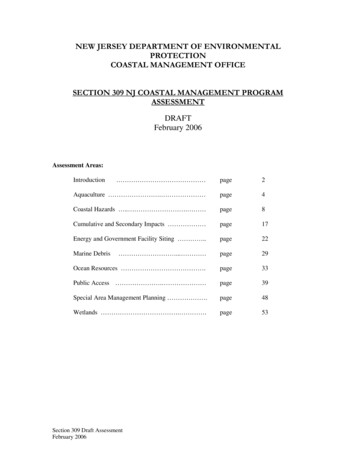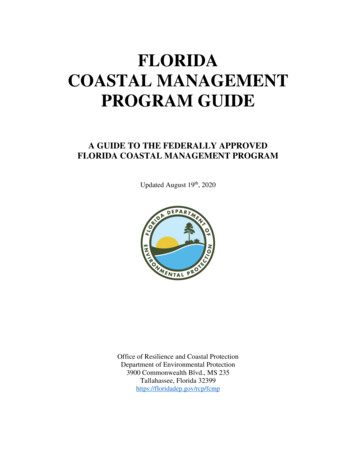
Transcription
FLORIDACOASTAL MANAGEMENTPROGRAM GUIDEA GUIDE TO THE FEDERALLY APPROVEDFLORIDA COASTAL MANAGEMENT PROGRAMUpdated August 19th, 2020Office of Resilience and Coastal ProtectionDepartment of Environmental Protection3900 Commonwealth Blvd., MS 235Tallahassee, Florida 32399https://floridadep.gov/rcp/fcmp
TABLE OF CONTENTSI. INTRODUCTION .3II. THE COASTAL ZONE MANAGEMENT ACT .4III. THE FLORIDA COASTAL MANAGEMENT PROGRAM .6PROGRAM BOUNDARIES.7FEDERAL CONSISTENCY .9Partner Agencies . 11Federal Consistency Enforceable Policies .,. 13Types of Federal Actions Reviewed . 15a) Federal Agency Activities . . . .15b) Federal Assistance to State and Local Governments .15c) Outer Continental Shelf Activities . . . .15d) Federal License or Permit Activities . .17AREAS OF SPECIAL MANAGEMENT.231) Areas of Critical State Concern (ACSCs) .242) Aquatic Preserve Systems .273) Surface Water Improvement and Management (SWIM) .314) Beach and Inlet Management Areas . . .33LAND ACQUISITION .37COASTAL MANAGEMENT SUBGRANT PROGRAM .39Coastal Partnership Initiative (CPI) Grants .49COMMUNICATION, OUTREACH, AND PUBLIC INVOLVEMENT . 40IV. APPENDIX .42CHAPTER 380, F.S., PART II, COASTAL PLANNING AND MANAGEMENT .43FCMP ENFORCEABLE POLICIES .51RULE 62S-4, F.A.C., CMP GRANTS .912Florida Coastal Management Program Guide
I. INTRODUCTIONThis guide is intended to provide the reader with a description of the Florida CoastalManagement Program (FCMP). The goal of the FCMP is to promote the effective protection anduse of the land and water resources of the coastal zone. FCMP’s website can be accessed byclicking on the following URL: https://floridadep.gov/rcp/fcmp.3Florida Coastal Management Program Guide
II. THE COASTAL ZONE MANAGEMENT ACTOur nation’s coastal zone is rich in a variety of natural, commercial, recreational, ecological,industrial, and aesthetic resources of immense value to the present and future well-being ofthe United States. By the late 1960s, more than half of our nation’s population was locatednear the coasts. Different groups competed for access to coastal resources, and conflictsincreased dramatically. Recreational fisherman competed with commercial fishermen.Resorts and residential developments limited the access previously enjoyed by localresidents. Declining coastal water quality led to closings of shellfish beds and swimmingbeaches. Commercial and recreational fisheries declined. Valuable coastal resources, whichare essential to the well-being of American citizens, were being irretrievably damaged orlost. The effective management, protection, and development of the coastal zone became amatter of national interest.In 1972, the U.S. Congress passed the federal Coastal Zone Management Act (CZMA)1 toaddress the increasing conflict between protection and use of our nation’s coastal zone. Thelegislation encouraged the nation’s coastal regions (collectively referred to as the “coastalstates” or “states”) to develop and implement federally-approved coastal managementprograms (CMPs) based on that state’s unique coastal characteristics. The managementprograms were to assist states to achieve wise use of the land and water resources of thecoastal zone, giving full consideration to ecological, economic, cultural, historic, andaesthetic values. The program was to be a comprehensive statement (in words, maps,illustrations, or other media of communication) that was prepared and adopted by the state inaccordance with the provisions of the CZMA. It sets forth objectives, policies, and standardsto guide public and private uses of lands and waters in the coastal zone. The CZMA2requires the state CMPs to describe: The boundaries of the state’s coastal zone.3The coastal land, water and natural resources that have a direct and significant impacton coastal waters.4Geographic areas of particular concern.5The authorities and enforceable policies of the CMP.6Guidelines on usage priority.7The organizational and enforceable policies for implementing the CMP, including theresponsibilities and interrelationships of local, area-wide, state, regional, andinterstate agencies and management process.81CZMA § 302-319 (also referred to as 16 U.S.C. § 1451 et seq.)CZMA § 306(d)(2) and (9)(also referred to as 16 U.S.C. § 1455(d)(2) and (9))315 U.S.C. § 923, Subpart D415 U.S.C. § 923, Subpart B515 U.S.C. § 923, Subpart C615 U.S.C. § 923, Subpart E715 U.S.C. § 923, Subpart C815 U.S.C. § 923, Subpart F and G24Florida Coastal Management Program Guide
Shorefront access and protection planning. This includes access to other publiccoastal areas of environmental, recreational, historical, aesthetic, ecological, orcultural value.9New energy facility planning.10Shoreline erosion/mitigation planning.11Once a state develops a CMP approved by the National Oceanic and AtmosphericAdministration (NOAA), that state becomes eligible for annual implementation funds. Thestate is also given the authority by Congress to review certain federal activities that havereasonably foreseeable effects on any land use12, water use13, or natural resource in its coastalzone to make sure that the federal actions are consistent with the enforceable policies of thestate's federally-approved CMP. This authority is referred to as “federal consistency.” Someexamples of “coastal land or water uses” include such activities as public access, recreation,fishing, historic or cultural preservation, development, energy infrastructure and use, hazardsmanagement, marinas, floodplain management, scenic and aesthetic enjoyment, and resourcecreation or restoration.915 U.S.C. § 923, Subpart C15 U.S.C. § 923, Subpart C1115 U.S.C. § 923, Subpart C12The term “land use” means activities which are conducted in, or on the shore lands within, the coastal zone13The term “water use” means a use or activity, or project conducted in or on waters within the coastal zone105Florida Coastal Management Program Guide
III.THE FLORIDA COASTAL MANAGEMENT PROGRAMIn 1978, the Florida Legislature adopted the Florida Coastal Management Act, codified asChapter 380, F.S., Part II, Coastal Planning and Management. This legislation authorizedthe development of the Florida Coastal Management Program (FCMP) and its submittalto the federal government.In 1981, the FCMP was approved by the Secretary of the National Oceanic andAtmospheric Administration (NOAA). The Department of Environmental Protection(DEP) is designated as the lead agency for the FCMP pursuant to the CZMA14. DEP’sOffice of Resilience and Coastal Protection is charged with overseeing the state’s coastalmanagement program and handles the following FCMP activities: Compiles and submits the federal applications for receiving funds pursuant to theCZMA. Adopts rule procedures and criteria for the evaluation of Coastal Partnership Initiative(CPI) and state agency sub-grant applications for funds allocated to the state underthe CZMA. Administers the Coastal and Estuarine Land Conservation Program (CELCP), afederally-funded land acquisition program. Conducts the CZMA Section 309 assessment and strategies for coastal resourceissues. Administers the Beach Access Sign Program, the Beach Warning Flag Program, andthe Rip Current Awareness Program. Prepares routine program updates to incorporate annual statutory changes. Maintains informational materials and procedural guidelines. Provides education and outreach materials. Guides the coordination of the Federal Consistency review process. Conducts training workshops for those entities involved in the federal consistencyprocess. Provides, to the practicable extent, financial, technical, research, and legal assistanceto effectuate the purposes of the Florida Coastal Management Act. Acts as a resource for the partner agencies in the Coastal Management Program.14CZMA § 306(c) (also referred to as 16 U.S.C. § 306(c))6Florida Coastal Management Program Guide
PROGRAM BOUNDARIES15The CZMA requires a state CMP to identify the boundary of its coastal zone, which includesthe area of land and water from the territorial limits landward to the most inland extent of marineinfluences. Following is a description of the seaward and interstate boundaries for the state ofFlorida: Seaward Boundaries – The CZMA16 defines the seaward extent of a state’s coastal zoneas “to the outer limit of state title and ownership under the Submerged Land Act17 .”.Under the Submerged Lands Act, Florida’s title and ownership extends three miles intothe Atlantic Ocean and, in accordance with United States vs. Louisiana, et.al., 364 U.S.502 (1960), three marine leagues (approximately nine nautical miles) into the Gulf ofMexico. Interstate Boundaries - The western lateral boundary of the FCMP is defined by theadjudicated boundary between Florida and Alabama. The coastal zone boundary inAlabama is the continuous 10-foot contour in Mobile and Baldwin counties. The northernlateral boundary of the state coastal program is the adjudicated boundary between Floridaand Alabama and Florida and Georgia. Each state, with the development of its owncoastal management program, has consulted with one another to ensure compatibilitybetween each state’s respective boundary designations.Based upon the geography of Florida and the legal basis for the state program, the entire state ofFlorida is included within the coastal zone. Geographically, Florida has low land elevation, agenerally high water table, and an extensive coastline with many rivers emptying into coastalwaters. Few places in Florida are more than seventy miles from either the Atlantic Ocean or theGulf of Mexico. The result is an interrelationship between the land and coastal waters, whichmakes it difficult to establish a boundary that would exclude inland areas. Because of thisinterrelationship, the state boundaries include the entire area encompassed by the state's 67counties and its territorial seas. The only exceptions are lands the federal government owns,leases, holds in trust, or whose use is otherwise by law subject to the sole discretion of thefederal government, its officers, or agents. Lands held by the Seminole and Miccosukee IndianTribes are also exempted.Note: For planning and developing coordinated projects and initiatives relating to coastalresource protection and management and for completing federal consistency reviews offederally-licensed and permitted activities18, only the geographical area encompassed by the 35Florida coastal counties and the adjoining territorial sea is utilized.15CZMA § 306(d)(2)(A) (also referred to as 16 U.S.C. § 1455(d)(2)(A))CZMA § 304(1) (also referred to as 16 U.S.C. § 1453(1))1743 U.S.C. 1301 et seq.18Section 380.23(3)(c), F.S.167Florida Coastal Management Program Guide
Following is a map of Florida’s Coastal Zone8Florida Coastal Management Program Guide
FEDERAL CONSISTENCY“Federal Consistency” is the requirement that Federal actions that affect any land, water, ornatural resource of a state’s coastal zone must be consistent with the enforceable policies19 of thestate. The FCMP federal consistency process consists of a network of 24 Florida Statutes (i.e.,enforceable policies) administered by DEP and a group of partner agencies responsible forimplementing the statutes. Federal consistency reviews are integrated into other review processesconducted by the state depending on the type of federal action being proposed. This frameworkallows the state to make integrated, balanced decisions that: Ensure the wise use and protection of the state’s water, property, cultural, historic, andbiological resourcesProtect public healthMinimize the state’s vulnerability to coastal hazardsEnsure orderly, managed growthProtect the state’s transportation systemSustain a vital economy.Consistency is based on effects rather than geographic boundaries so that there are no categoricalexclusions from the consistency requirement. This means that any federal activity or federallyfunded activity that will have an effect on a state's coastal zone will be subject to a consistencyreview unless specifically exempted by federal law. Effects are determined by looking atreasonably foreseeable direct and indirect effects on any coastal use or resource.The state of Florida has authority to review the following types of federal actions for consistencypurposes: Federal agency activities - activities and development projects performed by a federalagency, or a contractor for the benefit of a federal agency.Federal license or permit activities - activities performed by a non-federal entity requiringfederal permits, licenses, or other form of federal authorization. The federal consistencyreview for these activities are limited geographically to activities within the coastalcounties.Outer Continental Shelf (OCS) activities - The Bureau of Ocean Energy Management,Regulation, and Enforcement (BOEM) approvals for OCS plans, pursuant to the OCSLands Act for offshore minerals exploration or development.Federal assistance for state and local governmentsThe CZMA requires federal agency activities (i.e., “direct” agency activities) to be fullyconsistent with a state’s CMP, unless full consistency is prohibited by federal law. Federallicense, permit, and funding decisions (i.e., “indirect” agency activities) must be fully consistentwith the state’s approved coastal management program.The term “enforceable policy” means state policies that are legally binding through constitutional provisions,laws, regulations, land use plans, ordinances, or judicial or administrative decisions used by a state to exert controlover private and public natural resources, land uses, and water uses in the coastal zone, which are incorporated in amanagement program approved by NOAA.199Florida Coastal Management Program Guide
The federal consistency review process is one of the states' most powerful tools in protecting itscoastal assets as it allows the state to review any federal action within or outside of its coastalzone that affects any land use, water use, or natural resource. The DEP is the state's chiefenvironmental regulatory agency for air quality, water quality, water resource management,waste management, beach management, and springs protection. In coordination with the state’sWater Management Districts (WMDs) and the Department of Agriculture and ConsumerServices, DEP is the lead water policy agency. DEP manages state-owned lands, sovereignsubmerged lands, trails, parks, and preserves (including two million acres of coastal aquaticpreserves and three national estuarine research reserves).The following DEP programs conduct the state’s federal consistency reviews:a) The Office of Intergovernmental Programs, Florida State ClearinghouseThe Florida State Clearinghouse coordinates federal consistency reviews of proposedfederal activities, requests for federal funds, and applications for all federal licenses andpermits that do not require an analogous state permit.b) The Division of Water Resource Management, District OfficesThe District Offices coordinate federal consistency reviews of environmental resourcepermits (ERPs) for activities requiring an analogous federal license or permit in thecoastal counties.c) The Division of Water Resource Management; Beaches, Inlets, and Ports ProgramBeaches, Inlets, and Ports program coordinates consistency reviews of ERPs for activitiesrequiring an analogous federal license or permit that affect existing coastal conditions ornatural shore and inlet process.d) The Office of Resilience and Coastal Protection, Offshore Projects UnitThe Offshore Projects Unit coordinates consistency reviews of direct federal activitiesand federal license & permit activities that are proposed in the offshore Outer ContinentalShelf (OCS) waters.e) The Siting Coordination OfficeThe Siting Coordination office coordinates the interagency review and certification forbuilding and operating power plants, transmission lines and natural gas pipelines.10Florida Coastal Management Program Guide
Partner AgenciesDEP and the following partner agencies are charged with implementing the statutes and rulesincluded in the FCMP and are authorized to review and comment on the consistency of proposedfederal actions with the enforceable policies contained in the FCMP. If a state agency determinesthat a proposed federal activity is inconsistent, the agency must explain the reason for theobjection, identify the enforceable policies that the activity conflicts with, and identify anyalternatives that would make the project consistent. DEP, as lead agency for the FCMP, issuesthe formal state response to the appropriate party.The following agencies are charged with the implementation of the Florida Statutes that areincluded in the FCMP as enforceable policies: Florida Department of Agriculture and Consumer Affairs (DACS) manages state forestsfor multiple public uses through: wildfire prevention & management; water resourcemanagement; hydrologic restoration; development of best management practices forwater quality and water conservation; and implementation of Total Maximum Daily Loadrequirements for agriculture. DACS regulates aquaculture facilities and shellfishprocessing plants; opens and closes shellfish harvesting waters to protect human health;restores oyster reefs to maximize productivity; issues leases of sovereignty submergedlands for aquaculture; monitors shellfish meat for red tide cells and brevetoxins; andmanages an on-line real-time water quality monitoring program in shellfish harvestingareas. DACS also provides technical assistance, certification and training toapproximately 300 mosquito control programs and regulates the use of pesticides toprotect public health.Florida Department of Economic Opportunity (DEO), Division of CommunityDevelopment is the state land planning agency responsible for guiding Florida's growth.DEO oversees compliance with requirements for local government comprehensiveplanning, developments of regional impact, and development in areas of critical stateconcern. DEO assists local governments in hazard mitigation planning, post disasterredevelopment planning, and other initiatives to increase emergency preparedness andmitigate the short & long-term effects of hazard events. The special needs of coastalcommunities are being addressed by the Waterfronts Florida Program, marina facilitysiting strategies, and other initiatives. DEO also implements and administers numerouscommunity assistance and grant programs, including Front Porch Florida.Florida Department of Health (DOH), Division of Environmental Health regulatesdrinking water, on-site sewage disposal systems, monitors beach water for bacterialindicators & aquatic toxins, particularly harmful algal blooms, and administers manyother programs designed to reduce illness and prevent disease caused by exposure toenvironmental factors. In consultation with DEP and FWCC, DOH determines if toxinsare present in fish from Florida waters and issues fish consumption advisories as needed.Florida Department of State (DOS), Division of Historical Resources protects statehistorical and archaeological resources, including the regulation of treasure salvage in theoceans adjacent to Florida and the development of a system of underwater archaeologicalpreserves. The Division of Historical Resources also created the Florida Maritime11Florida Coastal Management Program Guide
Heritage Trail, which links coastal communities, forts, lighthouses, historic ports andhistoric shipwrecks.Florida Department of Transportation (DOT) develops and maintains the state’stransportation system. In consultation with state agencies and the Florida CoastalManagement Program, the DOT developed an early coordination process fortransportation project planning, known as Efficient Transportation Decision Making,which integrates federal consistency reviews with other project planning, developmentand evaluation processes.Florida Division of Emergency Management (DEM) ensures that Florida is prepared torespond to emergencies caused by a wide variety of threats, recover from disasters,mitigate disaster impacts, and reduce or eliminate long-term risk to human life andproperty. DEM Administers programs to help rebuild lives and communities, includingthe Public Assistance and Individual Assistance Programs, the Hazard Mitigation GrantProgram, the Flood Mitigation Assistance Program and the National Flood InsuranceProgram.Florida Fish and Wildlife Conservation Commission (FWC) protects and manages fresh& saltwater fisheries, marine mammals, birds, and upland game & non-game animals(including endangered species). FWC’s Fish and Wildlife Research Institute (FWRI) isthe state’s principle biological research entity. FWRI monitors changes in water qualityand levels of contaminants in Florida's fresh & marine waters, including levels ofmercury in fish; and monitors & tracks harmful algal bloom events.The Florida Building Commission of the Florida Department of Business andProfessional Regulation is a 25-member technical body responsible pursuant to Section553.73, F.S., for the adoption of the Florida Building Code. The current code is a singlestatewide code based on national model codes and consensus standards, amended forFlorida specific needs for the design and construction of buildings.The regional Water Management Districts (WMDs), which are organized alongwatershed lines, are responsible for the comprehensive planning, management anddevelopment of water resources for consumptive uses & water resource preservation. Thestate's WMDs, in partnership with the DEP, regulate activities in wetlands and otherwaters of the state. Pursuant to Sections 380.23 and 373.428, F.S., the WMDs areresponsible for conducting federal consistency reviews as part of permit reviews incoastal counties under Section 373 part IV, F.S. The five WMDs are:o St. Johns River Water Management District (SJRWMD)o Southwest Florida Water Management District (SWFWMD)o Suwanee River Water Management District (SRWMD)o South Florida Water Management District (SFWMD)o Northwest Florida Water Management District (NWFWMD)12Florida Coastal Management Program Guide
Federal Consistency Enforceable PoliciesFollowing is a list of the enforceable policies (statutory authorities) incorporated in the federallyapproved FCMP. An expanded version of the enforceable policies, which identifies by sectionand title the specific statute sections included in the program as enforceable policies, is includedin the appendix of this book and can be accessed by clicking on the following link:FCMP Enforceable Policies. Chapter 161 Beach and Shore PreservationNot approved as enforceable policy: Sections 161.011; .031; .0415; .05301; .071; .091;.111; .121; .144; .163; .181; .25; .26; .27; .28; .29; .31; .32; .33; .34; .35; .37; .38; .39;.40; .45; .52; .53; .57; .70; .72; .73; .74; and .76. Chapter 163, Part II Intergovernmental Programs: Growth Policy; County and MunicipalPlanning; Land Development RegulationEnforceable policy includes only Sections 163.3161; 3164; .3177; .3178; .3180(2);.3184; .3187; .3194(1)(a); .3202(2)(a-h); and .3220(2)&(3). Chapter 186 State and Regional PlanningNot approved as enforceable policy: Sections 186.005; .0201; .505; .512;; .513; and.901. Chapter 252 Emergency ManagementNot approved as enforceable policy: Sections 252.3569; .359; .3655; .515; .62; .63;.905; .921; and .9335. Chapter 253 State LandsNot approved as enforceable policy: Sections 253.01; .0251; .027; .031; .034; 61(1)(d);.7824; .7828; .87; and .90. Chapter 258 State Parks and PreservesNot approved as enforceable policy: Sections 258.001; .004; .014; .0142; .0145; .015;.016; .0165; .017; .021; .027; .034; .041; .081; .09; .11; .12; .14; .15; .158; .35; .36; .38;.43; .435; .46; and .601. Chapter 259 Land Acquisitions for Conservation or RecreationNot approved as enforceable policy: Sections 259.01; .03; .032; .0322; .035; .036; .037;.042; .045; .047; .05; .07; .101; .1051; .1052; .10521; and .1053. Chapter 260 Florida Greenways and Trails ActNot approved as enforceable policy: Section 260.011; .012; .0125; .013; .014; .0141;.0142; 0144; .015; .016; .0161; .017; .019; and .021. Chapter 267 Historical ResourcesNot approved as enforceable policy: Sections 267.011; .0612; .0617; .0618; .062; .0625;.071; .0731; .074; .0743; .075; .076; .081; .145; .16; .161; .17; .172; .173; .1732; .1735;and .1736. Chapter 288 Commercial Development and Capital ImprovementsEnforceable policy includes only sections 288.972 and .975. Chapter 334 Transportation AdministrationNot approved as enforceable policy: Sections .01; .03; .035; .044; .045; .046; .047; .048;.049; .05; .063; .065; .071; .131; .17; .175; .179; .185; .187; .193; .195; .196; .24; .27;.30; .351; .352; and .60.13Florida Coastal Management Program Guide
Chapter 339 Transportation Finance and PlanningEnforceable policy only includes: Sections 339.175 and .241.Chapter 373 Water ResourcesNot approved as enforceable policy: Sections 373.037; .044; .0465; .103; .1135; .171;.246; .308; .4143; .4144; .4146; .459; .4598; .462; .463; .472; .475; .535; .536; .584;.59; .5905; .701; .703; and .813.Chapter 375 Outdoor Recreation and Conservation LandsNot approved as enforceable policy: Section 375.031; 041; .044; .075.Chapter 376 Pollutant Discharge Prevention and RemovalNot approved as enforceable policy: Sections 376.011; .3073; .3075; .317; and .41.Chapter 377 Energy ResourcesNot approved as enforceable policy: Sections 377.06; .21; .22; .24(9); 24075;.242(1)(a)5; .2434; .2435; .6015; .801-.810; and .815.Chapter 379 Fish and Wildlife ConservationNot approved as enforceable policy: Sections 379.107; .206; .207; .212; .213; .214;.2202; .223; .2231; .2251; .2255; .2256; .2273; .2293; .2311; .2433; .359; and .362.Chapter 380 Land and Water ManagementNot approved as enforceable policy: Sections 380.06(24)(t); .0666; .23(3)(d); and .507.Chapter 381 Public Health; General ProvisionsEnforceable policy includes only Sections 381.001, .0011, .0012, .006, .0061, .0065,.00651; .0066, and .0067.Chapter 388 Mosquito ControlNot approved as enforceable policy: Sections 388.261 and .271.Chapter 403 Environmental ControlNot approved as enforceable policy: Sections 403.061(40); .0617; .0675; .076; .078;.08601; .0874; .1832; .414; .50663; .70611; .709; .7095; .7125(2)&(3); .7264; .763;.805; .8055; .871; .873; .874; .885; .928; and .941.Chapter 553 Building and Construction StandardsEnforceable policy includes only Section 553.79.Chapter 582 Soil and Water ConservationNot approved as enforceable policy: Sections 582.055; .06; and .32.Chapter 597 AquacultureNot approved as enforceable policy: Sections 597.001; 597.0021; .0045; and .005.14Florida Coastal Management Program Guide
Types of Federal Actions ReviewedThe state of Florida’s final consistency decision is based, in part, on the partner agencies’consistency findings. DEP, with assistance from partner agencies, reviews the following federalactions to ensure that all activities that have reasonably foreseeable coastal effects are consistentwith the enforceable policies of the federally-approved FCMP.a) Federal Agency ActivitiesA federal agency activity is any federal agency function performed in the exercise of itsstatutory responsibilities by a federal agency or by a contractor on behalf of a federal agencyother than those activities which pertain to the issuance of a federal license or permit; or thegranting of federal assistance. A federal agency activity does not include the issuance of afederal license or permit to an applicant or person.Review of federal agency activities is subject to the provisions of 16 U.S.C. § 1456(c)(1) &(2)20 and 15 C.F.R. 930, subpart C.Consistency reviews are conducted for the following types of federal agency activities: Proposals to physically alter coastal resources21 Plans used to direct future agency actions Proposed rulemaking that alters uses of the coastal zone Outer-Continental Shelf (OCS) leases issued pursuant to lease salesb) Federal Assistance to State and Local GovernmentsFederal assistance refers to a federal grant, contract, loan, subsidy, guarantee, insurance, orother form of financial aid provided to an applicant agency. Proposed activities eligible forfederal funding are those activities listed in the U.S. General Services Administrat
management, marinas, floodplain management, scenic and aesthetic enjoyment, and resource creation or restoration. 9 15 U.S.C. § 923, Subpart C 10 15 U.S.C. § 923, Subpart C 11 15 U.S.C. § 923, Subpart C 12 The term "land use" means activities which are conducted in, or on the shore lands within, the coastal zone

